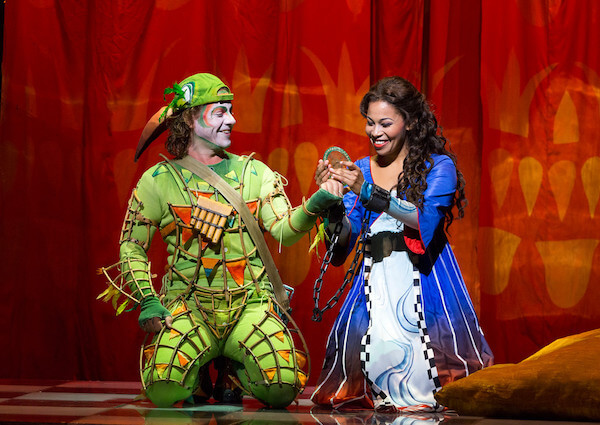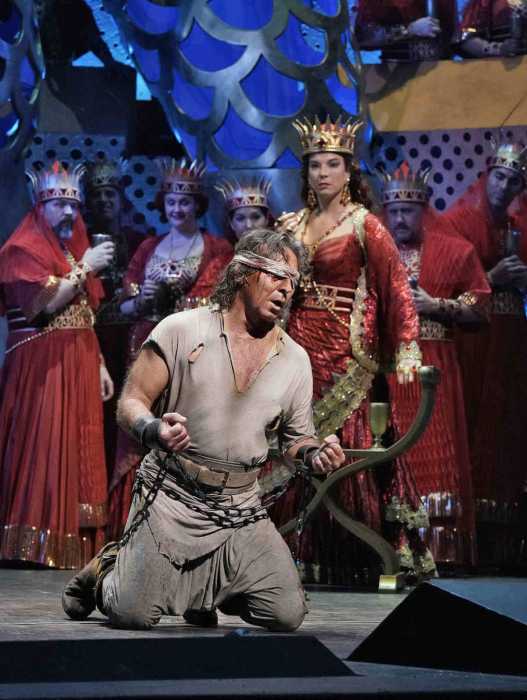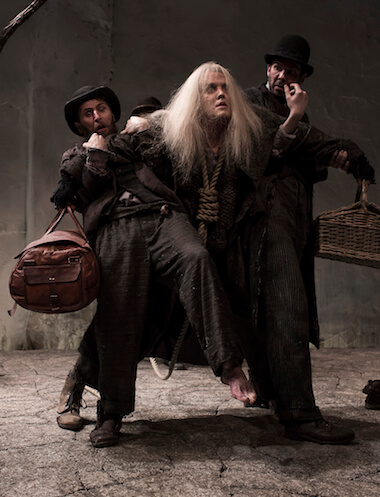Markus Werba and Golda Schultz by a Metropolitan Opera revival of Julie Taymor’s production of “Die Zauberflöte.” | RICHARD TERMINE/ METROPOLITAN OPERA
Fresh young talent can breathe life into revivals of older opera productions in the repertory. The fall season at the Metropolitan Opera featured several house debuts in major roles.
James Levine returned to conduct a revival of the admired Julie Taymor production of “Die Zauberflöte.” South African soprano Golda Schultz in the role of Pamina was radiant in her Met debut. Schultz’s gleaming soprano embodies youth mixed with a touch of vulnerability; onstage she is a natural communicator who connects with her colleagues and the audience. I have heard Pamina’s aria “Ach, ich fühl’s” sung with a longer, better controlled line but Schultz is a charming artist I hope becomes a Met regular.
On October 5, we were treated to another Met debut, that of Kathryn Bowden replacing Kathryn Lewek as the fearsome Queen of the Night. Bowden has sung the role at San Francisco Opera as a member of its Merola program, which accounted for her poise and assurance in a hair-raisingly exposed assignment. All the high F’s were present and accounted for, and Bowden’s lyric-coloratura soprano maintained a cool, bell-like purity throughout the range.
Golda Schultz, Angel Blue standouts in Met debuts; Anita Hartig stellar in “Les Contes d’Hoffmann”
Lyric tenor Charles Castronovo was a surprisingly virile, dark toned Tamino in his best Met outing so far. Austrian Markus Werba enacted a dudebro Papageno long on macho attitude but short on boyish naïveté. German bass Tobias Kehrer unfurled impressive deep tones as Sarastro but his burly, knotty timbre is more suitable for Hunding or Sparafucile. He couldn’t sustain the required smooth cantabile lines evoking Sarastro’s nobility and wisdom.
Levine’s conducting no longer possesses the same weight and energy as when the production was new but has gained in gentle insight and unforced flow. The Met orchestra played well for him. Taymor’s production, spiffed up for a new HD filming, was ably recreated by revival director David Kneuss.
Offenbach’s “Les Contes d’Hoffmann” returned in a strong, winning revival with three participants repeating earlier successes: Vittorio Grigolo in the title role, Erin Morley as the doll Olympia, and Laurent Naouri as the Four Villains.
Irish mezzo Tara Erraught made her Met debut in the extended role of Nicklausse and the Muse. A resident principal artist with the Bavarian State Opera known for Rossini coloratura mezzo roles, Erraught was the center of a media scandal when her Oktavian in a new Glyndebourne staging of “Der Rosenkavalier” was fat-shamed as “dumpy of stature” by Telegraph critic Rupert Christiansen. The petite and rather round shaped (though not fat) mezzo was visually and vocally unconvincing in the dual role of Hoffmann’s equivocal “friend” and the Muse. Erraught sounded like an immature lyric soprano with unsteady legato, weak resonance in her lower register, and a voice too small for the Met auditorium. She only achieved vocal brilliance on isolated high notes. Her best moment — unsurprising for a Rosina and Cenerentola — was her imitation of Olympia’s Doll Song scales. Erraught returns this season as Hansel and reportedly for future seasons — on this evidence, she is hardly Met material.
Inexplicable Met regular Oksana Volkova sang the irresistible courtesan Giulietta with a highly resistible, blowzy, colorless mezzo. Grigolo no longer portrays Hoffmann as a typical Latin hothead but now differentiates between the broken-down alcoholic of the prologue and the increasingly disillusioned idealistic lover of the succeeding acts. His ardently sung portrayal is touched with the self-destructive manic excitability of his Met Werther last season. Naouri interprets each villain with suave cynicism and dry wit; his intriguingly “sec” bass-baritone opens up excitingly in the upper and lower registers. Morley’s cool purity of tone and accuracy in coloratura scale work were unruffled by the acrobatic flourishes she added to each repeated verse of Olympia’s aria.
Anita Hartig is the best Antonia/ Stella this production has seen since Anna Netrebko at the premiere. Her smoky middle register evoked both willful sensuality and delicate frailty. In the big trio, Hartig’s silvery high notes soared easily over the orchestra and other soloists. As the Four Servants, tenor Christophe Mortagne invested each comic character with a distinct persona, inventive wit, and elements of surprise. Hearing Mortagne toss recitatives back and forth with the droll Naouri gave one the rare pleasure of hearing two native French speakers in French opera.
On October 18, a third native French singer was added to the mix when Gallic mezzo Géraldine Chauvet made her second appearance on the Met stage. Her more mature Nicklausse brought a jaded world-weariness to Hoffmann’s untrustworthy companion. Chauvet’s dark mezzo filled out each phrase with insinuating, idiomatic flair. Korean tenor Yosep Kang debuted the same night as Hoffmann. He initially seemed insecure and plagued by nerves — in the “Kleinzach” aria, his bright, plangent lyric tenor voice (better suited to Mozart and bel canto roles) choked up in several places. Kang eventually relaxed, stopped pushing his tone and made a pleasing small-scaled impression.
Youthful German maestro Johannes Debus brought considerable Romantic dash to Offenbach’s multifaceted score.
A routine revival of “La Bohème” was brightened by the anything but routine Met debut of soprano Angel Blue as Mimì. Blue’s lush, darkly brilliant soprano and tall, glamorous stage presence are actually too imposing for the delicate, consumptive French seamstress. However, the minute Blue walked onstage you didn’t look at anyone but her and when she opened her mouth, you didn’t hear anyone else on stage. This is a big healthy voice used with dramatic intent — she knows what she is singing about and why. I eagerly anticipate Blue’s steady development beyond the standard lyric soprano ingénue repertoire into juicier assignments that will exploit her full potential. One hopes the Met will keep her around and not push her too fast. This is a real voice that needs time to grow.
The offbeat casting of tenor Russell Thomas as Rodolfo gave Met audiences the rare opportunity to hear two African-American singers in the central romantic roles (Vinson Cole and Roberta Alexander sang one performance as Rodolfo and Mimì in the house in 1987). Thomas has a big, muscular and dark tenor (he recently sang the title role in “Otello” in concert with the Atlanta Symphony) that has rich resonance but can lose forward placement at the top (the Act I aria was in the lower key). He had good chemistry with Blue and also with Michael Todd Simpson’s intriguingly neurotic Marcello. Brigitta Kele’s minx-like Musetta displayed a distinctive cool soprano timbre that mixes spice and ice. Ginger British barihunk Duncan Rock debuted as a vivacious Schaunard with an undistinguished grainy light baritone. David Soar’s forgettable Colline was just undistinguished — better bass-baritones are available locally.
Alexander Soddy led a spirited performance that could have allowed a little more breathing room for his big-voiced leading couple.






































